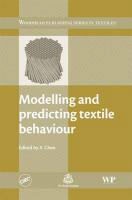Ulteriori informazioni
Informationen zum Autor Dr Xiaogang Chen obtained his PhD in Textile Engineering from the University of Leeds in 1991. He is currently a reader in technical textiles in the School of Materials! The University of Manchester. In the field of modelling! he worked on mathematical models leading to the creation of CAD software for 2D and 3D woven fabrics. He also researched into geometric and mechanical modelling of textiles for engineering technical textiles. He has applied his modelling approach into the prediction of textile behaviour in energy absorption! fluid filtration! textile composites and ballistic protection. Klappentext The textile industry can experience a vast array of problems. Modelling represents a group of techniques that have been widely used to explore the nature of these problems, it can highlight the mechanisms involved and lead to predictions of the textile behaviour. This book provides an overview of how textile modelling techniques can be used successfully within the textile industry for solving various problems. The first group of chapters reviews the different types of models and methods available for predicting textile structures and behaviour. Chapters include modelling of yarn, woven and nonwoven materials. The second group of chapters presents a selection of case studies, expressing the strengths and limitations and how various models are applied in specific applications. Case studies such as modelling colour properties for textiles and modelling, simulation and control of textile dyeing are discussed. With its distinguished editor and international range of contributors, Modelling and predicting textile behaviour is essential reading material for textile technologists, fibre scientists and textile engineers. It will also be beneficial for academics researching this important area. Zusammenfassung The textile industry can experience a vast array of problems, modelling can highlight the mechanisms involved and analyse useful predictive results for solving these problems. This book provides an overview of how textile modelling can be used within the textile industry. Inhaltsverzeichnis Part 1 Modelling the structure and behaviour of textiles: Structural hierarchy in textile materials: An overview; Fundamental modelling of textile fibrous structures; Yarn modelling; Modelling the structures and properties of woven fabrics; Modelling of nonwoven materials; Modelling and visualization of knitted fabrics. Part 2 Case studies: Modelling of fluid flow and filtration through woven fabrics; Modelling, simulation and control of textile dyeing; Modelling colour properties for textiles; 3D modelling, simulation and visualisation techniques for drape textiles and garments; Recognition, differentiation and classification of regular repeating patterns in textiles; Modelling of 3D cellular textile composites for protection against trauma impact; Development and application of expert systems in the textile industry....

